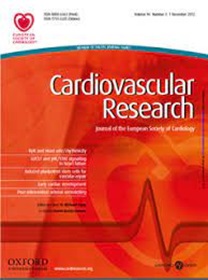Low-fibre diet is associated with high-risk coronary plaque features.
IF 13.3
1区 医学
Q1 CARDIAC & CARDIOVASCULAR SYSTEMS
引用次数: 0
Abstract
AIMS Diet is a determinant of cardiovascular diseases (CVD) with coronary disease as predominant cause of pre-mature death. To analyse how diet was associated with coronary atherosclerosis, including plaque features. METHODS AND RESULTS The cross-sectional population-based study using data from the Swedish CArdioPulmonary BioImage Study (SCAPIS) included 24 079 adults aged 50-64 years, recruited in 2013 to 2018 who were free of clinical cardiovascular disease. The recruitment and comprehensive examinations were conducted at six locations in Sweden. A dietary index (DI) based on a previously published anti-inflammatory DI including high proportion of plant-based foods, and low in red or processed meat and sugar-sweetened beverages was constructed. The reference group was within lowest DI tertile. Coronary atherosclerosis assessed by coronary computed tomography angiography, including any-, significant-, and adverse or high-risk coronary plaque, which is non-calcified with a significant stenosis ≥50%. Lowest, compared to highest DI tertile was associated with younger age, more often men (62.2% vs. 32.9%), higher high-sensitive C-reactive protein, more cardiometabolic risk and smokers, higher alcohol-, and higher energy-intake. In the highest and lowest tertile, coronary plaques were present in 36.3% and 44.3%, respectively, stenosis ≥ 50% in 3.7% and 6.0%. Non-calcified coronary plaques with stenosis ≥50% were present in 0.9% and 1.5% in highest and lowest tertiles. In multivariable analyses, the lowest tertile of DI was associated with high-risk plaque features after adjusting for age, sex, smoking, with waist circumference, triglycerides (TGs), and hypertension as possible mediators. CONCLUSION A low-fibre diet with high red meat content was associated with high-risk plaques features, increased coronary calcification and significant stenosis. Waist circumference, TGs, and hypertension emerged as potential mediators of these associations, underscoring the role of metabolic and hemodynamic factors in the dietary impact on coronary atherosclerosis. Our findings strengthen the importance of cardioprotective dietary recommendations.低纤维饮食与高危冠状动脉斑块特征相关。
目的:饮食是心血管疾病(CVD)的决定因素,冠状动脉疾病是过早死亡的主要原因。分析饮食与冠状动脉粥样硬化的关系,包括斑块特征。方法和结果:这项基于人群的横断面研究使用了瑞典心肺生物图像研究(SCAPIS)的数据,包括24079名年龄在50-64岁之间的成年人,他们于2013年至2018年招募,无临床心血管疾病。征聘和综合考试在瑞典的六个地点进行。根据先前公布的抗炎膳食指数,构建了膳食指数(DI),其中包括高比例的植物性食物,低比例的红肉或加工肉类和含糖饮料。参照组在最低DI分值范围内。通过冠状动脉计算机断层血管造影评估冠状动脉粥样硬化,包括任何严重的、不良的或高危的、非钙化且明显狭窄≥50%的冠状动脉斑块。与最高DI值相比,最低DI值与年龄更小、男性更常见(62.2%对32.9%)、高敏感c反应蛋白更高、心脏代谢风险更高、吸烟者、更高的酒精和更高的能量摄入有关。冠状动脉斑块发生率最高的占36.3%,最低的占44.3%,狭窄≥50%的占3.7%,狭窄≥50%的占6.0%。冠脉狭窄≥50%的非钙化斑块在最高分位和最低分位分别占0.9%和1.5%。在多变量分析中,在调整了年龄、性别、吸烟、腰围、甘油三酯(TGs)和高血压作为可能的介质后,DI的最低五分位数与高危斑块特征相关。结论低纤维高红肉饮食与高危斑块特征、冠状动脉钙化增加和明显狭窄相关。腰围、tg和高血压是这些关联的潜在媒介,强调了代谢和血流动力学因素在饮食对冠状动脉粥样硬化影响中的作用。我们的发现强化了保护心脏的饮食建议的重要性。
本文章由计算机程序翻译,如有差异,请以英文原文为准。
求助全文
约1分钟内获得全文
求助全文
来源期刊

Cardiovascular Research
医学-心血管系统
CiteScore
21.50
自引率
3.70%
发文量
547
审稿时长
1 months
期刊介绍:
Cardiovascular Research
Journal Overview:
International journal of the European Society of Cardiology
Focuses on basic and translational research in cardiology and cardiovascular biology
Aims to enhance insight into cardiovascular disease mechanisms and innovation prospects
Submission Criteria:
Welcomes papers covering molecular, sub-cellular, cellular, organ, and organism levels
Accepts clinical proof-of-concept and translational studies
Manuscripts expected to provide significant contribution to cardiovascular biology and diseases
 求助内容:
求助内容: 应助结果提醒方式:
应助结果提醒方式:


